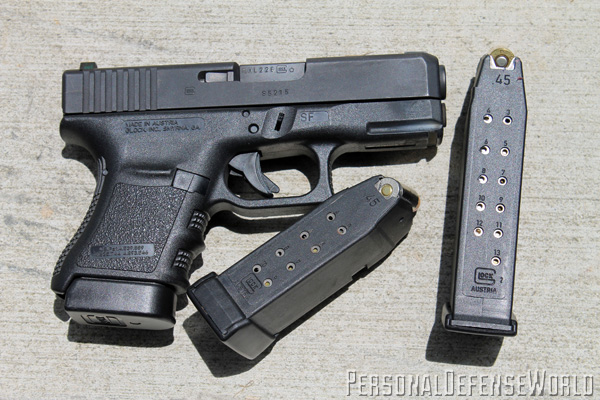In 1990, when I was taking the Instructor Course and Armorer Course at the Glock facility in Smyrna, Georgia, we students were introduced to Glock’s first prototype .45 ACP pistol, the Glock 21. It was a full-size handgun, essentially a Glock 17 scaled up to the .45 caliber, and its dimensions were not exactly geared for small hands. Alternatively, the G21 could be considered a 10mm Glock 20, which was engineered from the ground up for that powerful cartridge, now chambered for .45. Shooters very much wanted the G21, and as soon as it was introduced, it became the proverbial instant success. In the years that followed, the G21 became the most popular standard-issue .45 autopistol in American law enforcement. But—did I mention this already?—it was kind of large.
Glock introduced its first compact versions of the large-frame guns in 1997. The Glock 29 and the Glock 30 were the G20 and G21 “chopped and channeled” at the muzzle and butt. I got my hands on my first G30 in late March or early April 1997 and absolutely bonded with it. Though my eyes and the measuring tape didn’t reveal any discernible difference between the full-size G21 (13-round mag and 4.61-inch barrel) and the G30 (10-round mag and 3.78-inch barrel) in terms of reach to the trigger, the smaller G30 just fit my hand a lot better than the larger G21. I also noted that the G30 shot just a bit tighter. My test of the G21 had shown that it would shoot 1.5-inch groups, or a tad better, with five shots from a benchrest at 25 yards. But my shorter-barrel, early-production G30 twice gave me groups measuring under an inch—yup, five shots that measured 0.87 inches at their greatest distance from each other., once with 230-grain Federal Hydra-Shok and once with Remington 185-grain mid-range Match ammunition. It turned out that I couldn’t repeat it on demand, but that didn’t mean that the gun couldn’t. I was impressed with how soft the G30’s recoil was for a .45, even with +P loads. I found it reliable, too. Aluminum-case Blazer ammo of that period caused some problems feeding in Glock .45s, and I didn’t trust it then, although that problem seems to have gone away over the years. The G30’s necessarily strong, double captive recoil spring didn’t like super-light loads either—I had to hand-cycle those “softball” Remington semi-wadcutters. The 30 series was simply designed as combat guns and intended for combat loads. With those, the G30 was uber reliable. To make a long story short, the G30 quickly became my favorite Glock. My test sample never went back—I sent a check to Glock and bought the darn thing. It was to be the first of a series of compact Glocks in .45 ACP. Here we focus on one member of that family, the Glock 30SF.
The Short Frame
I sure wasn’t the only one who found the larger-frame Glocks a bit fat in the hand, with a far reach to the trigger. Glock listened to all of us, introducing its SF (Short Frame) series, which started with the G21SF. What was short was the dimension between the trigger and backstrap, the latter denoting the rear portion of the grip frame. This change better fit smaller hands and also allowed larger hands to get more flesh and bone around the handle. The next logical step was for Glock to give the same treatment to the smaller guns in its large-caliber series. My introduction to the Glock 30SF came in 2008, when I was shooting a Glock Sport Shooting Foundation (GSSF) match at the awesome Skip-J Range in Anderson, South Carolina. By that time, I’d had a grip reduction and reshaping done on my pet G30 by my old friend Rick Devoid at Tarnhelm Supply, where a great gun was made even better. I could get more hand around the gun and control it more effectively. Here’s the easiest way for me to explain this: Before, like most Glock 30s I’ve ever shot, my G30 needed a 6 o’clock hold to hit dead center. After Rick did the grip reduction, my G30’s point of impact went lower with the exact same grasp and stance, and it was suddenly hitting point-of-aim/point-of-impact with a centered sight picture. This told me that the gun was rising less in my hand in the instant between when the primer ignited the powder charge and the bullet left the muzzle…
Advertisement — Continue Reading Below
GET THIS ISSUE NOW! at personaldefenseworld.com/subscribe/concealed-carry-handguns/.











































